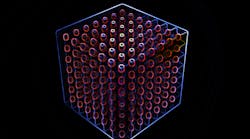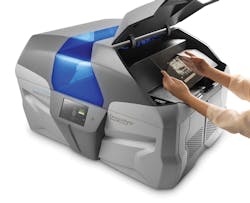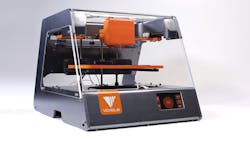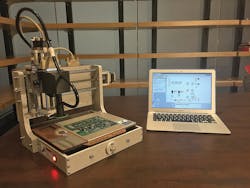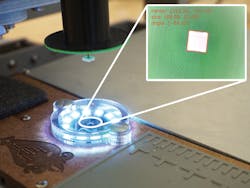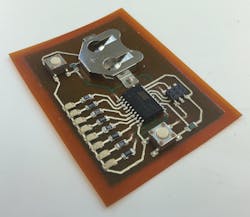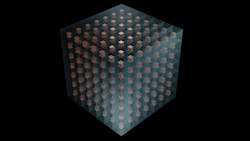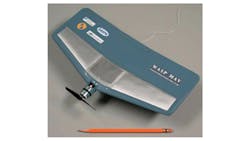Download this article as a .PDF
Although electronic devices have continued to shrink, many people agree that we can’t go much smaller because of the limits of silicon technology. As 3D printing circuits moves from concept to adoption, however, some companies are experimenting with this disruptive technology to take electronics to a new dimension. By 3D printing printed circuit boards (PCBs), designers can obtain faster prototypes and work in three dimensions. Plus, they’re no longer forced to buy additional boards they will never use. Several companies in the market are printing sensors, circuit boards, and more. This article will walk through who’s who in this market and how 3D printing technology is affecting the way engineers design.
Nano Dimension Ltd.
Founded in 2012, Nano Dimension is focusing on research and development into the 3D printing of advanced electronics, including conductive inks. The company noticed that printed-circuit-board (PCB) prototyping often only requires one of a few boards to test. However, many PCB fabricators required a minimum quantity that exceeded what was needed. In addition, it can take weeks for the PCBs to be delivered, as sometimes people order from other countries because it is more cost effective. Most of the world’s PCBs are manufactured in East Asia. In 2012, for example, China handled about 40% of the PCB market, according to Prismark Partners LLC.
With many 3D printing companies targeting the electronics space, the focus seems to be on the conductive inks. Mixing conductive materials with polymers does work, but generally is still nowhere close to the conductive properties of the traditional metals used for electronics. With today’s demands to extend battery life or reduce power consumption, increasing resistance with a less conductive material is not a favorable option. Instead, Nano Dimension developed a proprietary process for pico-liter deposition of silver and dielectric nano-inks. According to the company, it offers better performance in conductivity, thermal stability, and dielectric behavior than other 3D printable conductive material. It is a complex technology, but simply put, it is an inkjet printer building up layers of two materials that are 2 microns thick—one conductive, one dielectric. It is also possible to leave holes where necessary.
Voxel8
Started in 2013, Voxel8 came out of the Lewis Lab at Harvard. Even the MIT Technology Review put Voxel8 on its list of 50 Smartest Companies. The company offers materials, hardware, and software—its printer sells for about $9,000—but the key was its inks. The new material is about 2 million S/m.
Siemens
S/m stands for Siemens per meter. Siemens is an SI unit of electrical conductance, susceptance, and admittance. It is the reciprocal of an ohm. S = Ω−1 or A/V where electrical resistance and electrical conductance are G=1/R = I/V where:
S = seimens
Ω = ohms
A = amps
V = volts
G = electrical conductance
R = electrical resistance
I = the electrical current through an object
This is an inexpensive way to measure the conductivity of an electrolyte solution.
For comparison, conductive pastes are about 400 S/m and conductive filaments are in the 100 S/m range. The closest I found was Nano Dimension, which says it carries inks up to 35.7 million S/m and copper ranges from 49 to 60 million S/m. One big advantage of conductive inks is that they can print at room temperatures. “It takes the ink about 15 minutes to dry, but you don’t need to stop printing,” said Daniel Oliver, one of Voxel8’s co-founders. “The printer does not have to stop to let the ink dry. The ink can be printed over without stopping and its properties are not affected.”
The company’s current model does need to stop to place the electronics, however. While the Nano Dimension can print advanced circuits, Voxel8 prints connections and simple circuits. For example, a drone printed in a single print had to pause so someone could place in the electronics and motors. Then the print finished by encasing the electronics.
BotFactory
There are companies that also offer changeable heads that will grab electronics and place them in a circuit. For example, a New York City startup, BotFactory, sells a Squink PCB printer that is available for around $3,000. By offering a different head—one to print conductive material, one for non-conductive material, and one grabber to place the electronics—3D printing is able to offer so much more than just extruding plastic through a tube.
Optomec
All of these printers have one key variable: conductive materials. In 2015, Optomec was 3D printing sensors onto parts like airplane wings for stress strain analysis. The firm was working to figure out if it could cover more surface area than a traditional gauge. This year, it announced that Copper (Cu) and Copper/Nickel (CuNi; i.e., Constantan) inks have been successfully printed using Optomec’s patented aerosol jet technology. The inks used were from Applied Nanotech Inc., Intrinsiq Materials Inc., PV Nano Cell Ltd., and Kuprion Inc. Copper is a well-known material used in the electronics industry, and Constantan alloy is an established standard for critical sensing elements such as thermocouples and strain gauges.
This is an interesting move. Silver seems like it would be better suited, as it has higher conductivity than copper. Plus, silver doesn’t suffer from the same problems with oxidation. Despite this, Applied Nanotech is supplying Cu and CuNi-alloy inks to Optomec with confidence that the specialized hardware will shield these inks during the printing process. The material is able to be jetted on as narrow as 25 microns and at a thickness ranging from 60 to 250 nanometers. These new pastes and inks are able to fuse to bulk copper in a few minutes at temperatures as low as 392˚F. (The melt temperature of copper is about 1,900˚F.)
Duke’s Pratt School of Engineering
While new uses for inks and pastes are quickly being developed to change the PCB and sensor markets, filaments are certainly not being left behind. Recently, the Pratt School of Engineering at Duke University published “3-D Printers Open New Design Space for Wireless Devices.” The report details how the school was able to print an electromagnetic metamaterial using an electrically conductive material that can be printed in a standard fused filament fabrication (FFF) printer. This approach would save a lot of money compared to using a metal printer, such as a powder bed, as they often cost hundreds of thousands of dollars.
Filaments in general are not as conductive as inks. Yet Wiley and Shengrong Ye, a postdoctoral researcher in his group, created a 3D printable material that is 100 times more conductive than any filament on the market. It seems like they might be making a reference to Black Magic 3D, the first graphene based filament, as its volume resistivity is 0.6 ohm-cm. The new material, Electrifi Conductive 3D, is 0.006 ohms-cm. Electrifi Filament is a proprietary metal-polymer composite that consists primarily of a biodegradable polyester and copper.
This may not seem like a big step, as the resistivity of copper is 1.68 x 10−5 ohm-cm. Yet Steve Cummer, professor of electrical and computer engineering at Duke, thought that it might be conductive enough to create a 3D printed electromagnetic metamaterial (a synthetic composite of materials that are not found in nature). After testing, the 3D printed material interacted with the electromagnetic waves 14 times better than its 2D counterpart.
“The key is that we are able to exploit the fully 3D nature of the structure,” said Cummer. “For metamaterials, the strength of the response is connected to how much electric charge separation is produced within the structure. A well-designed 3D structure can simply hold much more charge than a 2D structure, even when the electric conductivity is not quite as good in the 3D case. The breakthrough here is how 3D copper structures can be made in such a simple way [using a standard desktop 3D printer].”
3D printing will make it easier to exploit the z-dimension in RF designs, opening up a whole new approach to designing RF components that were not previously practical. This can improve designs for mobile technology, which has limited space. Designing in 3D also can greatly improve the performance of an electronic device. A simple example is using a 3D printed antenna to improve a mobile phone’s signal without having to add towers or consume more power from the battery.
For some, moving from inks to conductive filament might bring back memories of Thomas’s work to explain multifunctional materials in the late 1990s. That research, which was sponsored by the Defense Advanced Research Projects Agency (DARPA), was looking to use, for example, the fuel tank in an aircraft to provide structural stiffness and improved fuel retention. This effort grew in the early 2000s; one of the projects was developing structural batteries for unmanned aerial vehicles.
“We were able to integrate lithium-ion cells into UAV wings as structural skin to reduce weight, which led to an increase in flight endurance time,” said Thomas. “Our research team…built several small electric-powered UAV prototypes or micro air vehicles…We were one of 10 or so different teams on this DARPA program that ranged in size from large to small with industry, university, and national laboratory participation.”
One of the biggest issues with electric vehicles—land, sea, and air—are that the range in which they can travel is limited by the battery. In addition, batteries often add a lot of weight, which also reduces performance and range. By developing new structural conductive materials that can be produced in complex geometries, as is possible with 3D printing, organizations might take a big step closer to improving electric vehicles.
The automotive and aerospace industries were among the first to adopt 3D printing technology. As the technology matures, it is now moving into the electronics industry. The companies able to adopt and design creative solutions that take advantage of 3D printing technology will expand not only 3D printing capabilities, but in terms of what their electronics can do and how much better they can perform. This may take time, but I see this trend following the same path we have seen in the automotive and aerospace industries. As new engineers are coming through the school system and learning this technology, we may really see a jump in design as they start entering the field.
